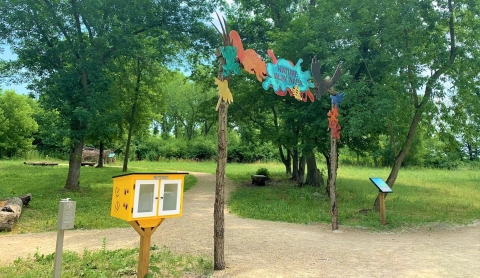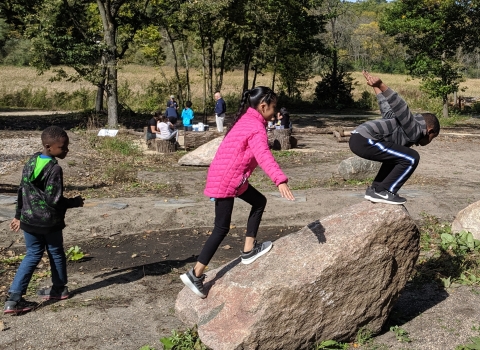When visitors approach the Minnesota River from Old Cedar Avenue today, they are greeted to a very different view than they would have seen 100 years ago. Or 50 years ago. Or even 10 years ago! Still, there has been one constant at this site over the past century: The Old Cedar Avenue Bridge.
A History of Connection
The Old Cedar Avenue Bridge, constructed in 1920, originally included two bridges to span the lengths of both Long Meadow Lake and the Minnesota River, forming the primary connection point between Bloomington and Eagan. As the Twin Cities Metro Area continued to expand, the existing pair of bridges proved incapable of handling the increase of vehicle traffic. Projects such as the Minnesota Zoo in Apple Valley (1978) and the Metropolitan Stadium in Bloomington (1982) ensured that the old bridge would not be able to support the travel needs of Minnesotans, and the state completed Highway 77 in 1980 as a replacement. Shortly after, the swing bridge over the river was removed and ownership of the Long Meadow Lake Bridge transitioned to the City of Bloomington.
Regular flooding in Long Meadow Lake continued to take its toll on the structural integrity of the bridge until the city closed it to automobiles in 1993. From this point, it became a popular place for pedestrians and cyclists, who used it to access many trails on either side. Unfortunately, with age the bridge continued to degrade, and the city made the decision to fully close the bridge in 2002. The future for the bridge at this point was quite muddy, but the waters began to clear when the National Park Service listed the bridge on the Register of Historic Places in 2013. This launched a collaborative restoration effort between the City of Bloomington and Minnesota Valley National Wildlife Refuge, resulting in the bridge reopening to the public in 2016 with a remodeled trailhead to complement.
Connecting People to Nature
Today, the Old Cedar Avenue Trailhead serves many purposes, and they all center around creating community and connecting them to wildlife. The restored land includes several features intended to provide the neighboring community with introductory experiences to nature, as well as opportunities to keep growing outdoor skills at the location, a key component to the U.S. Fish and Wildlife Service’s goal to provide Stepping Stones of Engagement. By spending a single morning at the pavilion (which features flush restrooms when the weather is warm enough), anyone can see the numerous different approaches people have to meaningfully engage with the outdoors.
In the early hours of the morning, wildlife viewers and runners begin to arrive. The bridge is a great starting point for trail runners due to its location serving as a nexus, with three trails beginning at the trailhead and numerous others reachable via connections.
Those observing wildlife, however, do not need to travel far. Heading East, the Bluff Trail leads into the forest, where numerous songbird species and woodland animals thrive. The big highlight for wildlife observers lies in the floodplain wetlands of Long Meadow Lake. The observation boardwalk allows visitors to get up close with the wetland, while the bridge itself offers great vantage points for viewing a diverse array of wildlife such as eagles, pelicans, soras, muskrats and raccoons.
Slightly later in the morning, Old Cedar Avenue attracts more cyclists, sometimes individual and sometimes in groups. The bridge is still critical for maintaining a connection between Bloomington and the communities south of Bloomington for the cycling community, and many people use the bridge to make their daily commute.
Families often also visit the trailhead which features a nature play area just past the pavilion to the east. Upon crossing the welcome arch created by Minneapolis artist Christopher Harrison, children can visit different stations and enjoy experiential learning by weaving eagle nests, constructing dams and making their own shelter amongst other activities. Each of these activities is labeled with a sign in Families can supplement this learning by taking books from the Little Free Library, which are stocked with books about Minnesota nature, fostering a sense of place-based learning from a young age at no cost.
Today, Old Cedar Avenue maintains a role in connecting trails and the two sides of the river, but perhaps more significantly, it is a location that brings people together and connects them with outdoor spaces. The versatility of the space allows for a wide range of approaches to make that connection, whether that connection takes them miles down a trail or simply to the pavilion for a picnic. No matter how you engage with nature, Old Cedar Avenue has something for you!
Learn more about different activities you can pursue on the refuge






